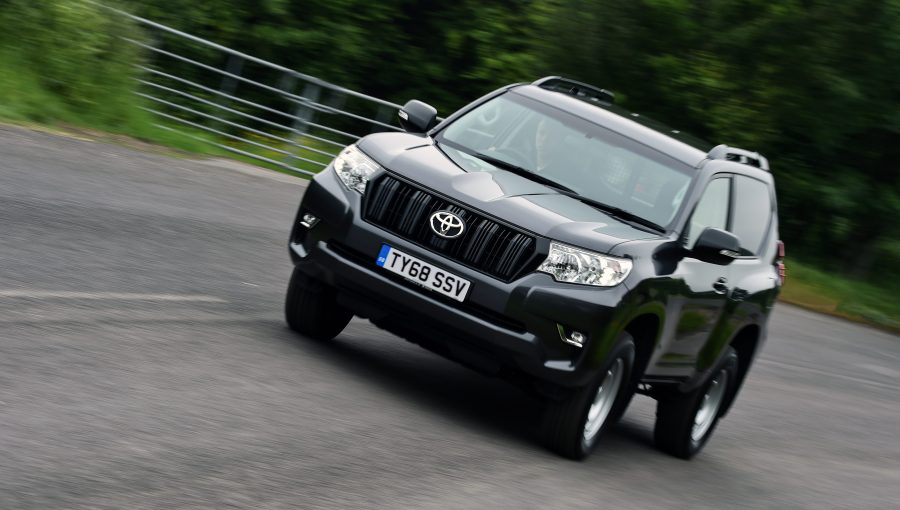Although Toyota’s passenger car range is predominantly focused around petrol-electric hybrid powertrains, the Land Cruiser, Hilux and Proace models are fitted with diesel engines. A diesel particulate filter (DPF) is a feature of these models, and you may have heard about the need for regular DPF regeneration. What does this component do and how do you take care of it?
What does a diesel particulate filter (DPF) do?
The DPF is fitted within the exhaust system and is designed to catch soot particles and nitrous oxide (NOx) from the combustion process that would otherwise be released into the atmosphere. The DPF is highly effective and traps around 80% of these harmful particulates.

Why do modern diesel engines need a DPF?
European legislation places strict exhaust emissions targets on all vehicle manufacturers. From September 2009, the Euro 5 legislative standard came into effect, part of which required all diesel cars registered from that point on to be equipped with a diesel particulate filter, or DPF.
These filters are used throughout the industry in all diesel-powered passenger vehicles, and their efficiency is vital now that stringent Euro 6d emissions standards are in force.
Do I need to replace a DPF during normal servicing?
Diesel particulate filters do have a capacity limit and can become full. But unlike traditional air, oil or pollen filters that need to be exchanged manually at regular intervals, the DPF has a much longer service life and is designed to regenerate to restore its performance.
The car’s electronic control unit (ECU) is programmed to do this automatically, neutralising the soot by burning it off at high temperature within the exhaust system while the vehicle is running. All modern cars with diesel engines follow this procedure.

How does DPF regeneration occur?
The regeneration occurs automatically, usually without the driver being aware that it is taking place. In the majority of cases, the process is carried out when the engine and exhaust system has reached normal operating temperature and the vehicle is travelling at over 40mph.
However, if your driving is limited to urban areas, the low speeds and frequent stops mean the conditions for normal regeneration do not exist. In these instances, the ECU monitors the accumulation of soot and instructs an alternative regeneration programme to begin well before the filter becomes saturated.
This programme injects small quantities of fuel into the engine after combustion, which increases the temperature within the exhaust system and creates an environment where it is possible to safely burn off the soot.
This method is very successful within the small percentage of vehicles where normal regeneration is not possible. However, due to the nature of city traffic, the regeneration process can be interrupted when the vehicle completes its short journey and is turned off. If this occurs, the ECU is programmed to recommence the process when the engine is restarted and back up to temperature again.

How can I help prevent DPF blockages in my Toyota?
Follow these four simple actions:
1. Regularly drive your Toyota on highways at speeds of between 40-55mph for around 20-30 minutes.
2. Avoid spending unnecessary amounts of time with the engine idling.
3, Try to limit the frequency of short journeys where the engine is running for less than ten minutes.
4. Do not ignore dashboard alerts related to the DPF.
Will I be warned if all DPF regeneration processes have been unsuccessful?
Very occasionally, use of the vehicle might be such that it will have been impossible for the ECU to complete the administration of any regeneration procedure. At this point, the DPF will have become overloaded and stopped functioning, so your Toyota will illuminate a warning light in the dashboard. It will then be necessary for the soot to be neutralised and the filter regenerated manually at a main dealer.
It is extremely unwise to ignore this visual warning as the DPF can become irreparably damaged. What’s more, it is illegal to remove the filter entirely.
Learn more: What is the exhaust gas recirculation valve and what does it do?





hi There
i have Toyota Rav 4 2011 A17ULV
i started getting engine management light with 4×4 and trc lights comes on all at once.
i had 7 months left in my car with Toyota Warranty, so i decided to take it to Local Toyota. they charge me £110 for diagnosing, they said you have P2002 1 and 2 coming up. they suggested to change EGR Valve trusted then asked them to replace it. that cost me £299. two weeks later i had same light came up on dash board, took it back they said now you need to change DPF filter. i asked how much would that be? ans was £1700. i mention that i had EGR replaced from you, so whats the guarantee you give if i have DPF filter change and the problem would not come back. the Ans was from dealers that we cant give out Guarantee. so basically at this rate i would be replacing all the parts in my Engine,
Car Goes on Limp Mode when this lights comes on.
any chance you can help please?
thanks
atul
Hi Atul,
Thanks for getting in touch. All blog comments have to go through an approval process so when your comment appeared removed it was just waiting for approval.
After speaking to our technical team they said that the P2002 is DPF trap efficiency, caused by a few factors, for example the wrong oil used at service, stop start driving, EGR fault, oil burning, etc.
Often an EGR can be cleaned if its coated in carbon. If you provide your EGR code, we’d be more than happy to look further in to this for you.
For P2002, the first thing to do would be a regen, force this through and then check the engine data to see if the block is clearing. If not it will need a DPF. If it starts to clear then the problem is sorted.
Alternatively, if your car has smoke coming out of the back at idle or fast idle (stationary and above 1500 rpm) and under hard acceleration when the engine is hot, the colour of smoke can tell a lot about what the engine is doing and its health.
We’d advise seeking a second opinion on the vehicle, or take it back to the dealer and ask them to submit a technical support case. Similarly, the Technical team at head office will be happy to review the actual data and advise the best course of action but would need the data from the vehicle.
If it is used in stop start driving or there is a certain colour of smoke then further work would be required.
Hope this helps.
Hi, my car VIN- SB1KC20E60F045985. Could you please tell me if I have a diesel particulate filter and what type of oil I should use? Thanks
Hi Kamil,
Thanks for getting in touch.
For your vehicle we would advise the following:
Oil grade = ACEA B1, API grade CF-4 or API CF.
Oil viscosity = 5W-30 (preferred), 10W-30, 15W-40 or 20W-50.
Oil capacity with oil filter change = 4.3 litres.
Hope this helps.
Thank you for reply, but i m still dont know if i have DPF filter?. Thanks in advance. Kamil
Hi Kamil,
Sorry for the confusion. We have checked with our Technical team and we can confirm that your vehicle does not have a DPF filter.
Thanks.
Hi
I have had my EGR replaced. I just took my car for run and all the black smoke came out from back of the exhaust. My DPF value shows 0%. That means in not blocked. My light still there.
I asked Toyota now they saing they need to change DPF filter. Even though it’s clean.
Seems like they just want RIP my money.
They have been scratching there heads too.
Hi Atul,
Thanks for getting back to us. You say that you have black smoke coming out from the back of the exhaust and that is an indication that the DPF cannot be on 0%, unless the DPF core has failed.
We’d advise going to your local dealer and get a data file sent to technical for assessment.
Thanks.
hello, is this services still active? is there an easier way to check for DPF?
VIN: NMTEA16R30R164871
Hi Mike,
Thanks for getting in touch.
We can confirm that it is not fitted with a DPF. We would advise checking to see if there is a differential pressure sensor fitted in the exhaust system, if there is not, there is no DPF.
Hope this helps 🙂
i have a toyota avensis, 2 liters, 2009. I have also white emissions. Not always but many times at speed up … please look at this video : https://youtu.be/33xzX4-Si6Q
Hi Sori,
Thanks for getting in touch.
We would suggest visiting your local Toyota Centre in your region. From the video you have attached, the white smoke is coolant being burnt which relates to water getting into the cylinder and being burnt during combustion. The level looks low at the moment but to avoid any damage we would advise that this is looked into by a qualified mechanic as soon as possible.
Thanks.
A toyota prado roll in the sea after an hour was towed out wash down with fresh water and remove wire clean and fitted back. But hard to start.
Hi,
Is it possible to tell whether my car has a DPF fitted, please?
The VIN is: VNKKC963X0A057877.
Many thanks,
Ian
Hi Ian,
Thanks for getting in touch. We can confirm that your vehicle does not have a DPF.
Hope this helps.
I have a diesel Auris 07 registration, which I suspect does not have a DPF filter. Will the car therefore fail its next MOT?
Hi John,
Thanks for getting in touch.
In order for our Technical team to look in to this for you, please could you provide us with your vehicles VIN number.
If you are not sure where to find it, please take a look at this link: https://mag.toyota.co.uk/toyota-vin-vehicle-identification-number.
Thank you.
I have a Toyota RAV4 2014 2.2 D-CAT Diesel and wondering if a treatment of Toyota Diesel Fuel System/Injector Cleaner (Part#: PZ46300PC004) will improve fuel economy and as well as reduce soot in the DPF/DPNR system?
Could you also advise how often should I use the system cleaner? Is this bad for the engine to use it frequently (i.e. every 3k miles)?
Many thanks for the help and advice in anticipation.
Hi Mr Racaza,
Thanks for getting in touch.
This cleaner is better than the off the shelf cleaners as it does the entire system – tank, lines, pump, head, valves, pistons, exhaust; it is also formulated to work with the engines and this means it can be much stronger.
If used every 3k, very little difference will be noticed in continual use. It is designed to be used annually / at every service, but using it more often is not harmful, but, it will cost more vs the received benefit to do this.
It works by cleaning, simply. A dirty fuel system causes restrictions making the pumps work harder. Carbon build up in the head, valves, cylinders and pistons cause the burn to be less efficient, so less value for money. Carbon build up in the exhaust causes a restriction which makes the engine work harder.
Cleaning not only improves the economy, it also reduces the risks of some issues caused by the build-up of carbon. So it is very beneficial, but at the cost per bottle vs the MPG improvements / fuel savings, once a service is enough to make it worthwhile.
We hope this helps.
Thanks.
Great. Thank you very much for the detailed reply Jessica. The information provided are very helpful. Cheers!
Hi,
Could you tell me if my car has a DPF fitted?
Also what type of oil should I use in my car?
Reg – FP08YLX
Thanks
Hi Oisin,
Thanks for getting in touch. We can confirm that your Auris does not have a DPF and we’d recommend engine oil specification is API CF-4 or CF and the recommended oil viscosity is: 5W-30.
Hope this helps.